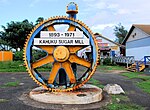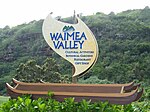Turtle Bay, Oahu
Bays of OahuBeaches of OahuPopulated places on Oahu

Turtle Bay is located between Protection Point and Kuilima Point on the North Shore of the island of Oahu in the U.S. State of Hawaii. Green sea turtles were known to feed in the bay, so residents renamed the area "Turtle Bay". This name predates the completion of the former Kuilima Resort Hotel and Country Club in May 1972, although it is not the bay's original name. The Bay is currently home to the famous Turtle Bay Resort, which includes hotels, cottages and a golf course. The James Campbell National Wildlife Refuge preserves a small pond adjacent to the golf course.
Excerpt from the Wikipedia article Turtle Bay, Oahu (License: CC BY-SA 3.0, Authors, Images).Turtle Bay, Oahu
Kamehameha Highway,
Geographical coordinates (GPS) Address Nearby Places Show on map
Geographical coordinates (GPS)
| Latitude | Longitude |
|---|---|
| N 21.701666666667 ° | E -158.00166666667 ° |
Address
Swing rope
Kamehameha Highway
96731 , Kawela
Hawaii, United States
Open on Google Maps










